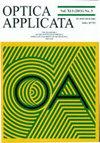动态大气湍流中相干与非相干组合激光束阵列的传输研究
IF 0.5
4区 物理与天体物理
Q4 OPTICS
引用次数: 1
摘要
高功率激光系统大多采用相干或非相干组合光束,以获得更高的激光输出功率以满足应用需求。然而,激光在大气中传播会降低远场光束质量。基于激光束阵列的传播模型,利用大气相干长度、激光持续时间和平均风速构建了以相屏序列为特征的大气动态湍流。同时,作为评价光束质量的指标,对远场相干和非相干组合光束的峰值强度和桶形强度进行了比较分析。结果表明,在较弱湍流环境下,相干组合光束在激光持续时间较短时比非相干组合光束具有优势,相干组合更适合于脉冲激光;随着激光持续时间的增加,非相干和相干组合光束的光束质量都降低并趋于接近。在较强湍流环境下,相干组合光束的光束质量与非相干组合光束非常接近时,相应的激光持续时间会缩短。研究结果可为大功率激光系统选择最佳光束组合方式以提高系统性能提供重要数据。本文章由计算机程序翻译,如有差异,请以英文原文为准。
Research on the propagation of laser beams arraywith coherent and incoherent combination in dynamic atmosphere turbulence
High-power laser systems mostly use coherent or incoherent combined beams to achieve higher laser output power to satisfy the application. However, the far-field beam quality of laser will be reduced when propagating over atmosphere. Based on the propagation model of laser beams array, we use atmospheric coherence length, laser duration and average wind velocity to construct dynamic atmospheric turbulence which is characterized as a phase screen sequence. Meanwhile, considered as the indexes to evaluate beam quality, peak intensity and intensity in bucket are comparatively analysed in coherent and incoherent combined beams in far-field. The results indicate that in weaker turbulence circumstances, coherent combined beam has an advantage compared with the incoherent combined beams when laser duration is short, and coherent combination is more suitable for pulsed laser. With laser duration is increasing, the beam quality of incoherent and coherent combined beams both decrease and tend to be close. In stronger turbulence circumstances, the corresponding laser duration will be shorter when the beam quality of coherent combined beams is extraordinary close to that of incoherent combined beams. The researches can provide important data for high-power laser system to select the optimal beam combination mode to improve its performance.
求助全文
通过发布文献求助,成功后即可免费获取论文全文。
去求助
来源期刊

Optica Applicata
物理-光学
CiteScore
1.00
自引率
16.70%
发文量
21
审稿时长
4 months
期刊介绍:
Acoustooptics, atmospheric and ocean optics, atomic and molecular optics, coherence and statistical optics, biooptics, colorimetry, diffraction and gratings, ellipsometry and polarimetry, fiber optics and optical communication, Fourier optics, holography, integrated optics, lasers and their applications, light detectors, light and electron beams, light sources, liquid crystals, medical optics, metamaterials, microoptics, nonlinear optics, optical and electron microscopy, optical computing, optical design and fabrication, optical imaging, optical instrumentation, optical materials, optical measurements, optical modulation, optical properties of solids and thin films, optical sensing, optical systems and their elements, optical trapping, optometry, photoelasticity, photonic crystals, photonic crystal fibers, photonic devices, physical optics, quantum optics, slow and fast light, spectroscopy, storage and processing of optical information, ultrafast optics.
 求助内容:
求助内容: 应助结果提醒方式:
应助结果提醒方式:


